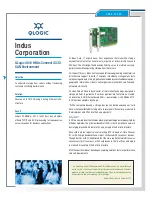
Port Management
Port Settings
162
Cisco 350, 350X and 550X Series Managed Switches, Firmware Release 2.4, ver 0.4
10
•
Port Description
—Enter the port user-defined name or comment.
•
Port Type
—Displays the port type and speed. The possible options are:
-
Copper Ports
—Regular, not Combo, support the following values: 10M, 100M,
1000M (type: Copper) and 10G.
-
Combo Ports
—Combo port connected with either copper CAT6a cable or
SFP
Fiber Gigabit Interface
.
-
10G-Fiber Optics—Ports with speed of either 1G or 10G.
-
OOB—Out-of-band port (supported only on the SG550XG/SX550X and
SG350XG/SX350X).
NOTE
SFP Fiber takes precedence in Combo ports when both ports are being used.
•
Administrative Status
—Select whether the port must be Up or Down when the device
is rebooted.
•
Operational Status
—Displays whether the port is currently Up or Down. If the port is
down because of an error, the description of the error is displayed.
•
Link Status SNMP Traps
—Select to enable generation of SNMP traps that notify of
changes to the link status of the port. Not relevant for the OOB port.
•
Time Range
—Select to enable the time range during which the port is in Up state.
When the time range is not active, the port is in shutdown. If a time range is configured,
it is effective only when the port is administratively Up.
•
Time Range Name
—Select the profile that specifies the time range. Not relevant for
the OOB port. If a time range is not yet defined, click
Edit
page.
Not relevant for the OOB port.
•
Operational Time-Range State
—Displays whether the time range is currently active
or inactive.
•
Auto Negotiation
—Select to enable auto-negotiation on the port. Auto-negotiation
enables a port to advertise its transmission speed, duplex mode, and Flow Control
abilities to the port link partner.
•
Operational Auto Negotiation
—Displays the current auto-negotiation status on the
port.
NOTE:
The
Interface
and
Port Description
are
displayed on the main page in the
Port
column.
















































